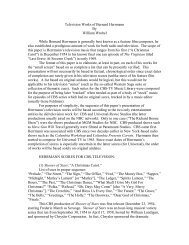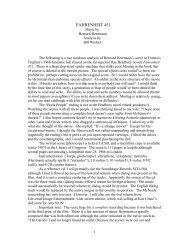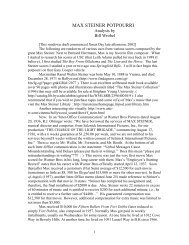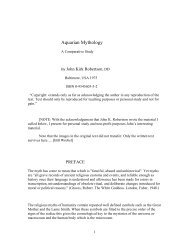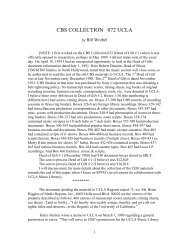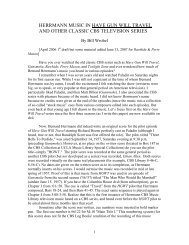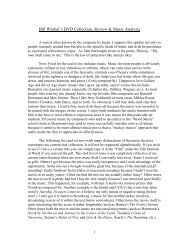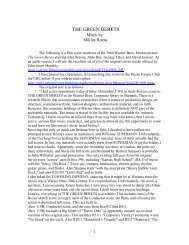Valentine's Day, Sunday, February 14, 2010 at 10:20 am
Valentine's Day, Sunday, February 14, 2010 at 10:20 am
Valentine's Day, Sunday, February 14, 2010 at 10:20 am
- No tags were found...
Create successful ePaper yourself
Turn your PDF publications into a flip-book with our unique Google optimized e-Paper software.
until once again we hear in the horns, the main theme given out as in the beginning,except in a far away manner. After this, the development section begins. It may beinteresting to note th<strong>at</strong> this development section also includes a kind of "falserecapitul<strong>at</strong>ion" in which the secondary themes of the first part are heard. This subsidesand the true recapitul<strong>at</strong>ion is soon heard, with the main themes rising to an impassionedclimax. The movement concludes with a short coda, during which the principal theme ofthe movement is given out once more, emp<strong>at</strong>hically, by the brass.The second movement is a Scherzo/ It might be called a hunt Scherzo. After a five barintroduction, the horns give out a sort of fast hunting call. This theme is of par<strong>am</strong>ountimportance, as it keeps recurring throughout the movement, as a kind of background tothe main theme of the Scherzo proper. At no time does this hunt figure ever really cease.Sometimes we hear it in the woodwinds, as though coming from a gre<strong>at</strong> distance. Atother times it rises and overpowers the real themes. And again it is presented gloomily inthe basses. The trio of the Scherzo is in the n<strong>at</strong>ure of a melancholy allegretto, performedmainly by the woodwinds. Its character was inspired to some extent by Milton's line from"Arcades--"nymphs and shepherds, dance no more." There is a return to the Scherzoproper, which is repe<strong>at</strong>ed in different instrument<strong>at</strong>ion and with many of the themesinverted. But once again, throughout, the hunt calls are always present. A five bar codafe<strong>at</strong>uring the timpani brings the movement to a close.The third movement is marked Andante Sostenuto, and is in the n<strong>at</strong>ure of an elegy.The clarinet gives out the main theme, a quiet, brooding melody. It is immedi<strong>at</strong>elyfollowed by the secondary theme in the flutes. After a due course of development thetempo becomes slower, as the solo trombone proclaims a new theme. This new themeand all the other themes of the movement are then developed to a climax. Finally theclarinet concludes the movement by st<strong>at</strong>ing the main theme once more.The last movement is in rondo form with an epilogue. The trumpet announces the maintheme, and with an abrupt change of tempo, the entire orchestra gaily picks it up. Thecontrasting m<strong>at</strong>erial used includes not only new themes, but one hears again the maintheme of the trio of the Scherzo, this time transformed from a melancholy piping to a gayand exuberant tune. Also the hunt call, which figured so prominently in the Scherzoproper reappears, but it is now more of a triumphant fanfare. The vigorous tempo of theRondo is broken only once, when a new motif is introduced. This theme, a tranquilallegretto, is introduced on the solo flute, accompanied by ancient cymbals in E. Themain theme soon returns, and the Rondo continues on its way, leading to a climax inwhich all the themes of the movement are combined. Then, suddenly, with an abruptchange of tempo, the epilogue begins. This is marked A La Processional. The clarinetsgive out still another version of the main rondo theme, now transformed into a slowmarch, accompanied by a rhythmical p<strong>at</strong>tern on the kettledrums. This seems to drawnearer and nearer, and finally rises to a triumphal climax, which brings the symphony to aclose.{Image http://img36.imageshack.us/img36/5533/r1<strong>14</strong>ag.jpg130




